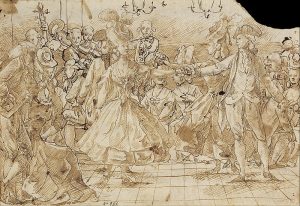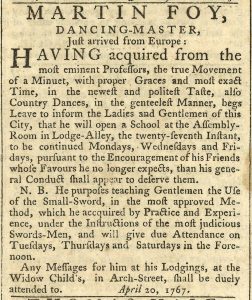
There are countless reasons why and how people do things for amusement. But, in Colonial America there were at least three reasons that influenced what people did for fun: social standing, location and gender.
Social class had a significant affect as wealthy planters were able to amuse themselves with more expensive forms of entertainment than the ordinary citizen. Aristocrats enjoyed horse racing, drinking and dancing. But ultimately it was dance that everyone was able to take pleasure in. Dancing also played a major role in the courtship of young men and women. Two types of dances existed in the colonies. There were the formal dances of the wealthy and upper middle classes and the lighthearted dances of the remainder of the population. In many cases, dancing was simply an excuse for a party and one of numerous activities at the event.
In 1774 Philip Fithian described a ball to which he escorted the wife and children of his employer, Virginia plantation owner Colonel Robert Carter. From about two in the afternoon until eleven that evening Fithian was fully occupied in conversation, dining and observing the beautiful surroundings and the activities of the other attendees at cards, singing, drinking and dancing.[1] A young person could exhibit proper breeding based on the gentility of his steps and a young lady could increase her chances for a successful marriage through demonstration of her social graces. Phillip Fithian, tutor to the Carter children, once noted the Virginian fondness for dance in his journal, saying, “Virginians are of genuine blood, they will dance or die!”[2]

Dance had always been popular, but Dance Masters who migrated to early America made it even more fashionable. French immigrants who often did not speak English and came here early in the 18th century taught dance as a way to earn money. Advertisements by Dance Masters were seen regularly in 18th century American newspapers where they offered instructions in dance classes that could be held in a hall, or private lessons were offered in an individual’s home. Most of the wealthy had grand ballrooms in their homes. Before the White House had an oval office, General Henry Knox built a magnificent oval ballroom in his home, Montpelier, in Thomaston, Maine, that was used as the main room for entertaining and dancing. Proper manners and social graces were also a crucial part of the training. Over the years the dances were modified, becoming simplified and less structured.
Dancing was a favorite pastime for all classes of people and also provided entertainment from the middle class to the poor. Cultural backgrounds established types of music and it could range from local country music in a barn to a wealthy gentleman’s ballroom. English Country dancing, which is believed to be the oldest form of folk dance is still being danced in the world. [3] For those that were not wealthy, it was an opportunity to socialize. For the elite, it was a way to show off their wealth.
Music in America was not composed here, but a combination of many ethnic backgrounds and brought over by countries such as England, Ireland, Germany, Africa, France and Scotland by the daring people who immigrated to the colonies.
To attend one of the splendid gala events one must also have dressed properly. Everyone turned out dressed in their best, officers powdered their hair as white as could be whitened, men of importance dressed in their finest embroidered silk suits and women dressed in their best hooped gowns, with their ruffled sleeves and large petticoats. What clothes a person wore always indicated their position in society.
On February 18, 1779, General Knox and his wife, Lucy, gave what has come to be known as The Grand Alliance Ball. General Washington and 400 others attended the festivities which was held on the estate of Aaron Boylan in Pluckemin, New Jersey. The celebration was held to remember the first anniversary of the Treaty of Alliance with France. Pluckemin was also the location of the first American military academy, established by General Henry Knox in 1778 in New Jersey. The ball was opened with General Washington dancing with Lucy Knox. On February 28, 1779, ten days after the ball, Henry Knox wrote to his brother William: “We had above seventy ladies, all of the first in the State, and between three and four hundred Gentlemen. We danced all night…”[4]
Participants bought tickets to the ball, their social credentials were reviewed and approved. The dance began with a minuet performed by one couple at a time. The prearranged order centered on a couple’s social standing, the most important couple dancing first.
The Father of Our Country was famous for his to love of dance. He is known to always end his annual Birthnight Ball by dancing it up, he was the first one out on the floor and the last to leave it. General Knox wrote his brother William describing in great detail the evening event, and mentioned that General Washington and Mrs. Caty Greene danced for three hours without sitting down once.[5]
The first public celebration of Washington’s Birthday was at Valley Forge during the winter of 1778 on February 22. The Virginia Gazette reported a ball for Washington’s Birthday on February 26, 1780. The first Birthnight Ball in Alexandria is documented in 1787. The first Birthnight Ball given by John Gadsby was on February 10, 1797. Washington did not attend because he was still serving as President in Philadelphia. In 1798, Washington attended the Birthnight Ball held in his honor. Washington once again attended the Birthnight Ball in 1799 and noted in his diary, “Went up to Alexandria to the celebration of my birth day. Many maneuvers were performed by the Uniform Corps. and an elegant Ball & Supper at Night.” [6]
If you ever find yourself in Alexandria, Virginia, and would like to dance at a Colonial Ball, stop at Gadsby’s Tavern, which George Washington frequented and where his Birthnight Ball is still being held to this day.








6 Comments
Thanks for the excellent post. My wife and I love to dance, so I’ve always been curious to read more about dancing and its social role during the period.
Our poor Marquis De Lafayette had a rather infamous dance with Marie Antoinette in which she laughed at his sloppy footwork. But the Marquis practiced and improved, and his example gives hope to all people with two left feet.
Even if you get laughed at by a queen, don’t give up!
Thank you for the note. How fun that you and your wife love to dance! You certainly would enjoy General Washington’s Birthnight Ball in Alexandria. You would even get to wear period clothes and “The General” himself shows up to dance and dine with his guests!
What a wonderful article!!! I have read how much George Washington loved to dance. It is refreshing to know that he could enjoy company and dance when he appears to have always had to be so serious and thoughtful.
Thank you very much for the compliment. George Washington could “cut a rug”! The General noted it was relaxing and fun and it is said that he was seen dancing with a bottle of wine sticking out of one of his pockets!
A very nice, insightful article on the role of dance during this period. Over the past 5 years I’ve become more interested in life during the Revolutionary War period. I became curious about dance in March of this year after witnessing colonial dancers at the Visitor’s Center at Guilford Court House Battlefield, in Greensboro, NC. The dancers were in elegant period clothing, and the music was baroque and delicate. The dancers moved so beautifully and precise, so expressive of proper gentle manner…I was mesmerized! I was envious of their skill…I’m sure I’d stumble and fall if I tried to learn…but it was wonderful to watch!